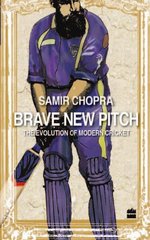Brave New Pitch
David Mutton |Published: 2012
Pages: 224
Author: Chopra, Samir
Publisher: HarperCollins
Rating: 4 stars

Before getting into this review, I should declare that I know Samir Chopra a little, having occasionally watched matches with him and discussed the state of the game over a few beers.
Conflict of interest statement over I can happily declare his book a triumph. Brave New Pitch defies easy categorization. Part love letter from a lifelong fan, part analysis of the modern game, it also contains philosophy and social history, economics and sports politics.
The strand that runs most deeply through the book is the role of the nation in cricket’s past, present and future. Chopra points out the obvious but often overlooked reality that the national boards act as proxies for their nations: the England team is actually just an ECB eleven, and the Indian team are the representatives of the BCCI. This edifice, he argues, is ripe for change, and the Indian Premier League may succeed where World Series Cricket and the ill-fated Indian Cricket League failed.
Although a potential destroyer of the international structure of cricket, the IPL is not simply a benign, globalized brand of the game, with well-paid players from across the cricketing world (and occasionally further afield) coming together under franchises. Chopra explores its impact on the longer formats, its prioritization of club over country and obsession with sixes (or DLF maximums). He also investigates the paradoxical situation of the IPL breaking down borders but symbolizing national pride as a face of modern Indian. Its ugly side is seen in the continued exclusion of Pakistani players following the Mumbai bombings and the all too common online diatribes from Indian fans blindly defending the IPL.
This focus on the nation offers analytical insight but occasionally Chopra overplays his hand. Sport can be tribal without any national identities as anyone who has watched a football derby can testify. Is this type of behaviour the fault of nationalism or the inevitable consequence of passionately supporting a team? He also mistakes the case for limiting overseas and Kolpak players in county cricket. This is not mindless griping about Johnny Foreigner but ensuring maximum bang for the ECB’s investment in developing players for their national team.
Chopra’s vision for the future is a world of supra-franchises, where teams play in the Big Bash League, the IPL and across the world. This international league could play almost year-round, attract global support and investment, and put an end to the cosy cartel of the ICC. As Chopra points out, the worst case scenario is not a cricket world run by franchises but an alphabet soup of competing tournaments. Rather optimistically he hopes that the new rulers would play five day games in addition to T20 contests.
In these strange times the picture has changed even since the book’s publication. The franchise model no longer appears all-conquering. The Big Bash League has lost money in both of its seasons and failed to attract investors for any franchises, both the Bangladesh Premier League and Sri Lanka Premier League struggled to pay players on time, and ambitious plans for a competition in the USA have yet to get off the ground. There is no doubt that the T20 format is a sustainable, long term cash cow but outside of the IPL there is little evidence that franchises bring greater rewards than the old domestic structures. Over the next few years we will see whether the IPL is a model for the rest of the world or an outlier that exists due to the exceptional nature of the Indian market.
Brave New Pitch is more than just a discussion about the future. There are novel solutions to several problems that plague us today: free test match tickets to improve the televised product, greater simplicity and similarity across the formats, and smart phones or tablet computers for umpires so that they can hook themselves directly up to technology and avoid the DRS.
Along the way there are fascinating droplets of social history. Chopra recounts Indian?s wonderment of encountering Channel 9’s coverage in 1985 after enduring decades of the state-run Doodarshan channel. His history of cricket on the internet has rarely been bettered, with the current combination of friendly communities and aggressive, anonymous comments traced back to the early days of IRC chat relays and usenet groups.
This is not the book to buy your relative who quite likes cricket. Its subject matter will appeal to only to people whose lives are drenched in the sport but for those of us whose fit that criteria it is a must read. Chopra asks the right questions, motivated by a fan’s love of the game, and although readers may not agree with all of his solutions the debate is timely and can not be left to the administrators alone to resolve.






Leave a comment